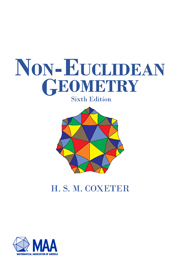Book contents
- Frontmatter
- PREFACE TO THE SIXTH EDITION
- Contents
- I THE HISTORICAL DEVELOPMENT OF NON-EUCLIDEAN GEOMETRY
- II REAL PROJECTIVE GEOMETRY: FOUNDATIONS
- III REAL PROJECTIVE GEOMETRY: POLARITIES, CONICS AND QUADRICS
- IV HOMOGENEOUS COORDINATES
- V ELLIPTIC GEOMETRY IN ONE DIMENSION
- VI ELLIPTIC GEOMETRY IN TWO DIMENSIONS
- VII ELLIPTIC GEOMETRY IN THREE DIMENSIONS
- VIII DESCRIPTIVE GEOMETRY
- IX EUCLIDEAN AND HYPERBOLIC GEOMETRY
- X HYPERBOLIC GEOMETRY IN TWO DIMENSIONS
- XI CIRCLES AND TRIANGLES
- XII THE USE OF A GENERAL TRIANGLE OF REFERENCE
- XIII AREA
- XIV EUCLIDEAN MODELS
- XV CONCLUDING REMARKS
- APPENDIX: ANGLES AND ARCS IN THE HYPERBOLIC PLANE
- BIBLIOGRAPHY
- INDEX
XI - CIRCLES AND TRIANGLES
- Frontmatter
- PREFACE TO THE SIXTH EDITION
- Contents
- I THE HISTORICAL DEVELOPMENT OF NON-EUCLIDEAN GEOMETRY
- II REAL PROJECTIVE GEOMETRY: FOUNDATIONS
- III REAL PROJECTIVE GEOMETRY: POLARITIES, CONICS AND QUADRICS
- IV HOMOGENEOUS COORDINATES
- V ELLIPTIC GEOMETRY IN ONE DIMENSION
- VI ELLIPTIC GEOMETRY IN TWO DIMENSIONS
- VII ELLIPTIC GEOMETRY IN THREE DIMENSIONS
- VIII DESCRIPTIVE GEOMETRY
- IX EUCLIDEAN AND HYPERBOLIC GEOMETRY
- X HYPERBOLIC GEOMETRY IN TWO DIMENSIONS
- XI CIRCLES AND TRIANGLES
- XII THE USE OF A GENERAL TRIANGLE OF REFERENCE
- XIII AREA
- XIV EUCLIDEAN MODELS
- XV CONCLUDING REMARKS
- APPENDIX: ANGLES AND ARCS IN THE HYPERBOLIC PLANE
- BIBLIOGRAPHY
- INDEX
Summary
Various definitions for a circle. We have seen that both elliptic geometry and hyperbolic geometry can be derived from real projective geometry by singling out a polarity. In the present chapter, so far as is possible, we give the definitions and theorems in such a form as to apply equally well in either of these non-Euclidean geometries.
In §8.6 we generalized the concepts “bundle” and “axial pencil” (§2.1) in such a way that any line and plane belong to a bundle, any two planes to a pencil. Those lines of a bundle which lie in a plane of the bundle are said to form a flat pencil (§10.1). Thus any two coplanar lines determine a flat pencil. In the proof of 8.61, we saw that any flat pencil can be constructed as a plane section of an axial pencil. We now make the analogous generalization of the concept “circle.”
A circle is the class of images of a point by reflection in the lines of a flat pencil. The lines are called diameters, their common point the centre, and the absolute polar of this point the axis. In elliptic geometry this will be seen to agree with our previous definition (§6.5). But in hyperbolic geometry we have to distinguish three cases: a proper circle (the “circle” of §9.1) has an ordinary centre and an ultra-infinite axis; a horocycle has parallel diameters, so that its centre and axis are at infinity; and an equidistant curve has ultra-parallel diameters, all perpendicular to the axis, while the centre is ultra-infinite.
- Type
- Chapter
- Information
- Non-Euclidean Geometry , pp. 213 - 223Publisher: Mathematical Association of AmericaPrint publication year: 1998



